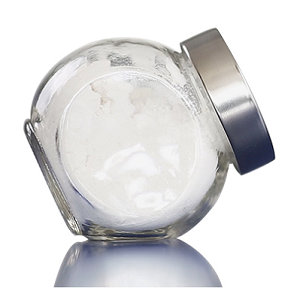3,3'-Dimethoxy-benzidin Chemische Eigenschaften,Einsatz,Produktion Methoden
ERSCHEINUNGSBILD
FARBLOSE KRISTALLE.
PHYSIKALISCHE GEFAHREN
Die D?mpfe sind schwerer als Luft und k?nnen sich am Boden ausbreiten. Fernzündung m?glich.
CHEMISCHE GEFAHREN
Zersetzung beim Verbrennen unter Bildung giftiger Rauche mit Stickstoffoxiden. Reagiert mit Oxidationsmitteln.
ARBEITSPLATZGRENZWERTE
MAK: Krebserzeugend Kategorie 2; (DFG 2005).
TLV nicht festgelegt (ACGIH 2005).
AUFNAHMEWEGE
Aufnahme in den K?rper durch Inhalation, über die Haut und durch Verschlucken.
INHALATIONSGEFAHREN
Eine gesundheitssch?dliche Partikelkonzentration in der Luft kann beim Versprühen oder Dispergieren schnell erreicht werden, vor allem als Pulver..
WIRKUNGEN NACH WIEDERHOLTER ODER LANGZEITEXPOSITION
Wahrscheinlich krebserzeugend für den Menschen.
LECKAGE
Pers?nliche Schutzausrüstung: Atemschutzger?t, P3-Filter für giftige Partikel. Chemikalienschutzanzug. Verschüttetes Material aufsaugen.
R-S?tze Betriebsanweisung:
R45:Kann Krebs erzeugen.
R22:Gesundheitssch?dlich beim Verschlucken.
S-S?tze Betriebsanweisung:
S53:Exposition vermeiden - vor Gebrauch besondere Anweisungen einholen.
S45:Bei Unfall oder Unwohlsein sofort Arzt zuziehen (wenn m?glich, dieses Etikett vorzeigen).
Chemische Eigenschaften
o-Dianisidine, crystallizes dimorphically, rarely in needles, with mp 133°C , often in flakes with mp 137-138°C . It forms colorless crystals, but commercial products have a tinge of violet. It is sparingly soluble in water but soluble in alcohol, ether, and benzene. One gram of ethyl acetate dissolves 0.285 g of o-dianisidine at 73°C .

The pure compound is stable upon exposure to air, but commercial products turn violet. o-Dianisidine is resistant to water but sensitive to oxidizing agents.
Verwenden
o-Dianisidine is a starting material for the production of disazo dyes and pigments.
Like benzidine and o-tolidine, o-dianisidine forms colors with numerous oxidizing agents, e.g., copper, cobalt, and gold ions. o-Dianisidine is quantitatively determined by titration with nitrite using potassium iodide and starch paper as the indicator. o-Dianisidine can be detected in the urine using potassium 1,2-naphthoquinone4-sulfonate after extraction. A rapid and easy method is based on the color formed with cyanogen bromide. Its detection limit is 0.05 mg/kg.
The free o-dianisidine base and the dihydrochloride are marketed in moist forms with a 10-30% water content.
synthetische
2-Nitroanisole is reduced (H2-catalyst or iron-formic acid) to o-anisidine or (benzidine-type reaction) to o-dianisidine [119-90-4], both of which are important as dye intermediates.
Allgemeine Beschreibung
Colorless crystals or a light brown powder. Turns violet on standing. Carcinogen.
Air & Water Reaktionen
Finely powdered material is a significant dust explosion hazard. Insoluble in water.
Reaktivit?t anzeigen
o-Dianisidine is a weak base. Reacts exothermically with acids. Sensitive to heat, air and prolonged exposure to light.
Brandgefahr
o-Dianisidine is combustible.
Toxikologie
In the presence of rat liver homogenate, o- dianisidine is positive in the Ames test. It is capable of inducing unscheduled DNA synthesis inHeLa cells and in primary rat hepatocytes, and it provokes cell transformation in baby hamster kidney cells in vitro. o-Dianisidine is carcinogenic in rats. An oral dose of 30 mg administered three times per week for 13 months produced tumors in the zymbal glands and in other tissues. No conclusive epidemiological studies have been reported on the carcinogenicity of o-diani- sidine in humans. No MAK value has been established. o-Dianisidine is classified in group III B.
Sicherheitsprofil
Confirmed carcinogen
with experimental tumorigenic data.
Moderately toxic by ingestion. Mutation data
reported. Combustible when exposed to
heat or flame. When heated to
decomposition it emits toxic fumes of NOx.
Carcinogenicity
o-Dianisidine is reasonably anticipated to be a human carcinogen based on sufficient evidence of carcinogenicity from studies in experimental animals.
3,3'-Dimethoxy-benzidin Upstream-Materialien And Downstream Produkte
Upstream-Materialien
Downstream Produkte
Tetranatrium-6,6'-[(3,3'-dimethoxy[1,1'-biphenyl]-4,4'-diyl)bis(azo)]bis[4-amino-5-hydroxynaphthalin-1,3-disulfonat]
Direct Blue 151
3,3'-Dihydroxybenzidine
Dinatrium-3-[[4'-[[6-amino-1-hydroxy-3-sulfonato-2-naphthyl]azo]-3,3'-dimethoxy[1,1'-biphenyl]-4-yl]azo]-4-hydroxynaphthalin-1-sulfonat
3,3'-dihydroxy-[1,1'-biphenyl]-4,4'-dicarboxylic acid
Dinatrium-3,3'-[(3,3'-dimethoxy[1,1'-biphenyl]-4,4'-diyl)bis(azo)]bis(4-hydroxynaphthalin-1-sulfonat)
1-Naphthalenesulfonic acid, 4-amino-5-hydroxy-6-[[4'-[(4-hydroxyphenyl)azo]-3,3'-dimethoxy[1,1'-biphenyl]-4-yl]azo]-, monosodium salt
1,6-Naphthalenedisulfonic acid, 7-[[4'-[(6-amino-1-hydroxy-3-sulfo-2-naphthalenyl)azo]-3,3'-dimethoxy[1,1'-biphenyl]-4-yl]azo]-8-hydroxy-, trisodium salt
Tetranatrium-[μ-[[3,3'-[(3,3'-dihydroxy[1,1'-biphenyl]-4,4'-diyl)bis(azo)]bis[4,5-dihydroxynaphthalin-2,7-disulfonato]](8-)]]dicuprat(4-)
C.I. Direct Black 87
Tetranatrium-6,6'-[(3,3'-dimethoxy[1,1'-biphenyl]-4,4'-diyl)bis(azo)]bis[4-amino-5-hydroxynaphthalin-1,3-disulfonat]
DIRECTVIOLET32
2,7-Naphthalenedisulfonic acid, 3,3'-[(3,3'-dimethoxy[1,1'-biphenyl]-4,4'-diyl)bis(azo)]bis[5-chloro-4-hydroxy-, tetrasodium salt
1-Naphthalenesulfonic acid, 3-[[4'-[(2,4-diamino-5-methylphenyl)azo]-3,3'-dimethoxy[1,1'-biphenyl]-4-yl]azo]-4,6-dihydroxy-, monosodium salt
2-Naphthalenesulfonic acid, 6-amino-3-[[4'-[(4-amino-6-sulfo-1-naphthalenyl)azo]-3,3'-dimethoxy[1,1'-biphenyl]-4-yl]azo]-4-hydroxy-, disodium salt
DIRECT BLACK 91
Direct Blue 151
DIRECT BLUE 98
Direct blue 215 (C.I. 24415)
DIRECT BLUE 80

